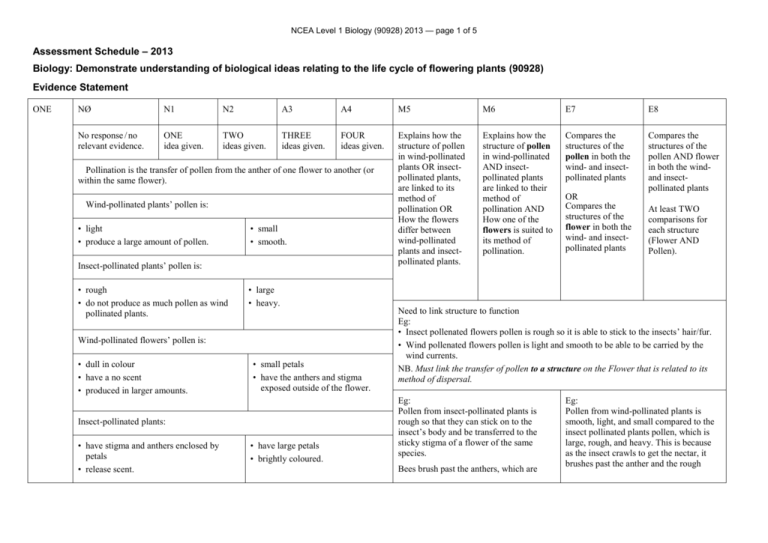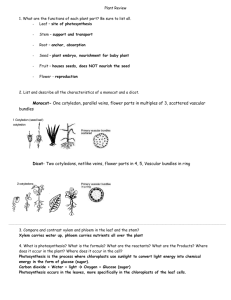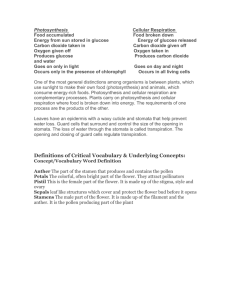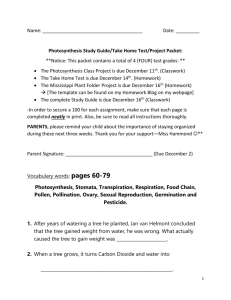93KB - NZQA
advertisement

NCEA Level 1 Biology (90928) 2013 — page 1 of 5 Assessment Schedule – 2013 Biology: Demonstrate understanding of biological ideas relating to the life cycle of flowering plants (90928) Evidence Statement ONE • • NØ N1 N2 A3 A4 M5 M6 E7 E8 No response / no relevant evidence. ONE idea given. TWO ideas given. THREE ideas given. FOUR ideas given. Explains how the structure of pollen in wind-pollinated plants OR insectpollinated plants, are linked to its method of pollination OR How the flowers differ between wind-pollinated plants and insectpollinated plants. Explains how the structure of pollen in wind-pollinated AND insectpollinated plants are linked to their method of pollination AND How one of the flowers is suited to its method of pollination. Compares the structures of the pollen in both the wind- and insectpollinated plants Compares the structures of the pollen AND flower in both the windand insectpollinated plants Pollination is the transfer of pollen from the anther of one flower to another (or within the same flower). Wind-pollinated plants’ pollen is: • light • produce a large amount of pollen. • small • smooth. Insect-pollinated plants’ pollen is: • rough • do not produce as much pollen as wind pollinated plants. • large • heavy. Wind-pollinated flowers’ pollen is: • dull in colour • have a no scent • produced in larger amounts. • small petals • have the anthers and stigma exposed outside of the flower. Insect-pollinated plants: • have stigma and anthers enclosed by petals • release scent. • have large petals • brightly coloured. OR Compares the structures of the flower in both the wind- and insectpollinated plants At least TWO comparisons for each structure (Flower AND Pollen). Need to link structure to function Eg: • Insect pollenated flowers pollen is rough so it is able to stick to the insects’ hair/fur. • Wind pollenated flowers pollen is light and smooth to be able to be carried by the wind currents. NB. Must link the transfer of pollen to a structure on the Flower that is related to its method of dispersal. Eg: Pollen from insect-pollinated plants is rough so that they can stick on to the insect’s body and be transferred to the sticky stigma of a flower of the same species. Bees brush past the anthers, which are Eg: Pollen from wind-pollinated plants is smooth, light, and small compared to the insect pollinated plants pollen, which is large, rough, and heavy. This is because as the insect crawls to get the nectar, it brushes past the anther and the rough NCEA Level 1 Biology (90928) 2013 — page 2 of 5 contained with the petals and the rough pollen sticks to its body / is put in pollen sacs. The insect-pollenated flowers are brightly coloured, large and scented to attract pollinators. Pollen from a wind-pollinated plant is light and small so that it can be carried by the wind currents to another flowers stigma of the same species. The Stigma is feather and has a large surface area so that it can catch the pollen carried by the wind. The Anthers are droopy and exposed to the wind currents so it can transport the pollen to other plants. Wind-pollinated flowers are dull and have little or no scent. pollen sticks to the insect’s body and is then transferred to the sticky stigma of the flower of the same species of plant as the insect searches for nectar. The smooth light pollen is designed to be picked up and carried by the wind and maybe transferred to the feathery stigmas of plants of the same species. This means that less pollen is required by the insect pollinated plant than the wind-pollinated plant as the wind-pollinated relies on saturation of pollen to get a least one plant pollinated. The stigma and the anthers are held externally outside the flower in wind pollinated flowers compared to the insect pollinated plants, which are held internally inside. This is because the external feathery structure of the stigma in wind-pollinated plants increases the surface area, which increases the chances of pollination Etc. NCEA Level 1 Biology (90928) 2013 — page 3 of 5 TWO NØ N1 N2 A3 A4 M5 M6 E7 E8 No response / no relevant evidence. ONE idea given. TWO ideas given. THREE ideas given. FOUR ideas given. TWO of: • Explains how fertilisation occurs. • Explains what happens to the flower after fertilisation. • Explains why dispersal is important to the plant. ALL of • Explains how fertilisation occurs. • Explains what happens to the flower after fertilisation. • Explains why dispersal is important to the plant. Links explanations to discuss how fertilisation changes the structure of the flower and why this is important to at least ONE type of seed dispersal linked to explanation. Links explanations to discuss how fertilisation changes the structure of the flower and why this is important to at least TWO different types of seed dispersal linked to explanation. • • • • • • • • • • Fertilisation is where the male pollen nuclei/sperm fuse with the egg nuclei. The pollen tube grows down the style towards the ovary. The ovary expands and swells, forming the fruit. (must link ovary to fruit) The ovules become the seeds. The petals and the anthers and other reproductive components fall off, exposing the fruit. The seeds are dispersed by animals, wind, or water. Flower starts to die – petals fall off /stamens drop off. Reduces competition for named resource seedling will compete for with parent plant. Ovum/egg fuses with pollen. Pollen lands on the stigma. Competition for named resource. Eg: Sunlight, minerals, water and space Dispersal to better conditions An explanation of how plant fertilisation is complete when the male nucleus (sperm) passes down the pollen tube to fuse with the egg cell. As it is attracted to the chemicals released by the ovary, which determine the direction for the pollen tube to grow towards. After fertilisation the ovule will swell and become the fruit, which carry the seeds ready to be dispersed. Dispersal of seed reduces competition with the parent plant. The pollen grain lands on the stigma then grows a pollen tube down to the ovum and the egg where the nuclei of the pollen fuse with the egg. The petals of the flower drop off and the ovary swells and develops into the fruit while the fertilised eggs become the seeds. This is important as this advertises to the animals that the fruit is eatable and encourages them to eat it and disperse it away from the parent plant. OR the fruit develops hooks and barbs, which attach to the animal’s fur to be dispersed. Another method is that the fruit develops wings,ππ which are carried by the wind away from the parent plant. This is important to the plant, as it reduces competition with the parent plant as it is dispersed further away and is not in direct competition for light, water and minerals with the parent plant when it germinates. NCEA Level 1 Biology (90928) 2013 — page 4 of 5 THREE NØ N1 N2 A3 A4 M5 M6 E7 E8 No response / no relevant evidence. ONE idea given. TWO ideas given. THREE ideas given. FOUR ideas given. TWO of: • Explains the importance of photosynthesis for Elodea. • Explains the effects of increasing or decreasing light intensity has on the Elodea plant. • Explains why a solution of potassium hydrogen carbonate (KHCO3) was used in this experiment. • Explains the importance of photosynthesis for Elodea AND explains the effects that increasing or decreasing light intensity has on the Elodea plant. AND • Explains why a solution of potassium hydrogen carbonate (KHCO3) was used in this experiment. OR data is correctly used in explanation of bubbles. • Links explanations to discuss the importance of photosynthesis for Elodea. • Explains the effects that increasing or decreasing light intensity has on the Elodea plant. • Limitations of carbon dioxide increasing by light intensity. Little or no increase • Explains why a solution of potassium hydrogen carbonate (KHCO3) was used in this experiment. • Links explanations to discuss the importance of photosynthesis for Elodea AND explains the effects that increasing or decreasing light intensity has on the Elodea plant. • Explains why a solution of potassium hydrogen carbonate (KHCO3) was used in this experiment. • Data from the table used to justify correct statements. • Answer makes a clear link between the results of the experiment and the process of photosynthesis. NCEA Level 1 Biology (90928) 2013 — page 5 of 5 Describes the process of photosynthesis as: A word equation OR • A chemical equation (all species including light energy must be present, a balanced equation is not required for Achievement, but reactants and products must be identified correctly). • 6CO2 + 6H2O C6H12O6 + 6O2 • Describes that as the light increases, so does the number of bubbles produced. OR decreasing light intensity decreases the number of bubbles produced. • Identifies that chlorophyll is the plant pigment responsible for absorbing light energy. • Provides energy for plant • Links bubbles to production of oxygen. • Explains that the number of bubbles represents the amount of oxygen produced by the process of photosynthesis. • Links increasing production of oxygen to an increasing light intensity. • Explains that photosynthesis creates glucose that can be used in respiration to provide the energy (ATP) which the cell can then use to carry out cellular processes like growth and reproduction. • Explains that by increasing the light intensity, the rate of photosynthesis increases until it reaches a point where increasing the light intensity no longer increases the rate of photosynthesis. AND That photosynthesis is limited by the factor that is supplied in the least amount. • The potassium hydrogen carbonate solution was supplied so that CO2 was available as a primary reactant required for photosynthesis and would not limit the amount of photosynthesis that could occur. Eg: In this experiment Elodea is supplied with carbon dioxide and the light intensity is varied. This shows that as the light intensity increases, so does the rate at which photosynthesis occurs until it reaches 2200 lux where an increase in light intensity does not increase the rate of photosynthesis. Photosynthesis is limited by the factor that is in the least amount, eg carbon dioxide, light intensity and frequency, temperature and water availability. Photosynthesis can also be affected by the amount of chlorophyll the Elodea has and the frequency of light that is used in the experiment. This is because the Elodea is not able to photosynthesise and gain the required energy in the form of C6H12O6, which can then be used to create energy though respiration as ATP, which can be used in the cell for cell processes such as growth and repair and cell division. Judgement Statement Score range Not Achieved Achievement Achievement with Merit Achievement with Excellence 0–8 9 – 13 14 – 18 19 – 24






